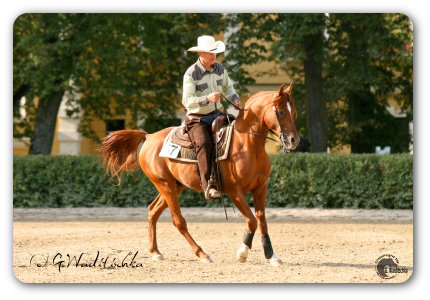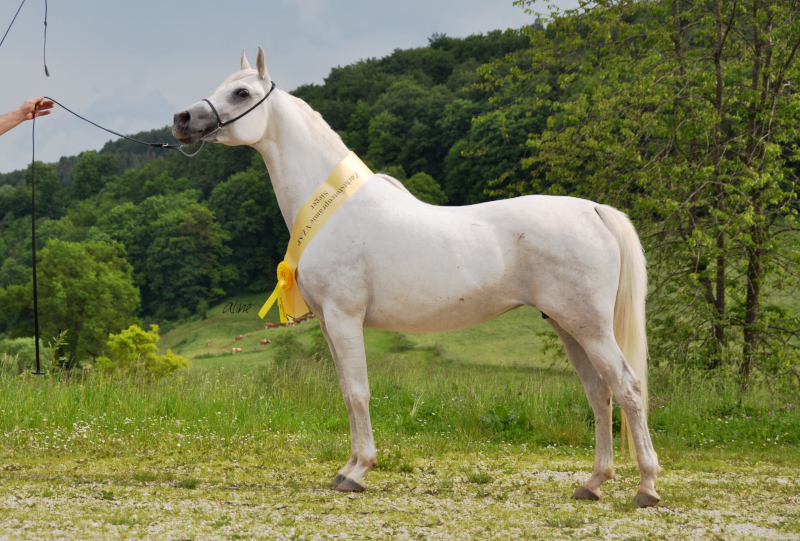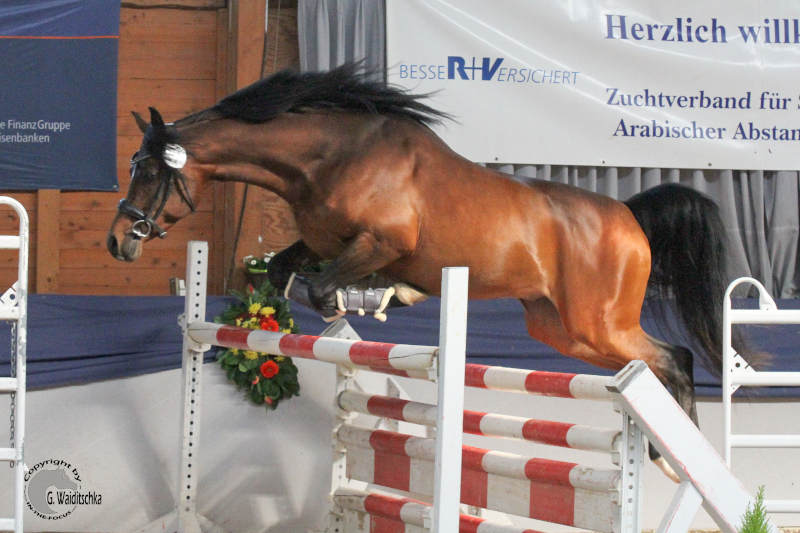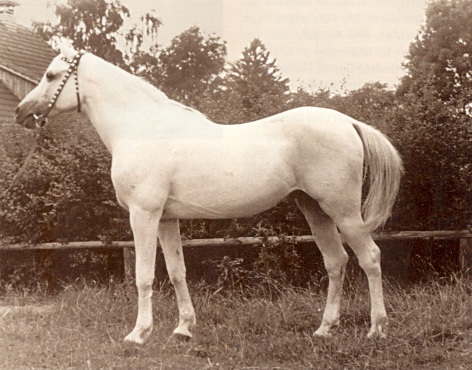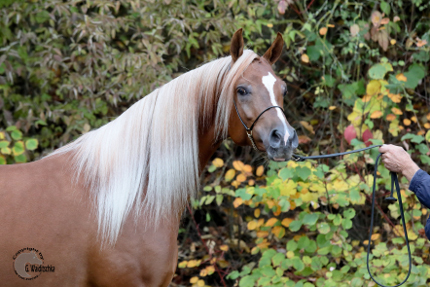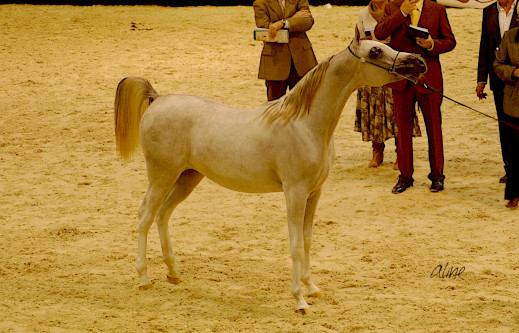Mabrouk Manial
Mabrouk Manial was a grey stallion by Saklawi II, born in 1912 at the Manial stables of Prince Mohammed Ali in Egypt.
Mabrouk Manial's dam was Tarfa, a grey Koheylah Mimriyeh who traced to Freiha El Hamra, a desert bred mare of bay color. Freiha El Hamra was imported to Egypt by Prince Ahmad Kamal in the late 1880's.
Tarfa also produced Hadban, a half-brother to Mabrouk Manial. Through Tarfa, Mabrouk Manial came from the same strain than Mansour who sired the legendary Nazeer.
Although Mabrouk Manial sired only nine foals, especially his daughters were exceptional breeding individuals.
His daughters included Bint Radia, Sabah, Saada and Mahroussa, one of the most photographed mares of her time.
Bint Radia produced the stallions Hamdan and Shahloul and the mares Zamzam and Samira.
The daughter Sabah was well-known by her daughter Bint Sabah and her daughters Bint Bint Sabah and Bukra who founded their own families in and outside Egypt.
The grey Mahroussa was the most influential of all Mabrouk Manial daughters outside Egypt. She was the dam of Fadl and Zarife and dam of Maaroufa anf HH Mohammed Ali's Hamama.
Fadl and Maaroufa became foundation stock at Babson Farms in the United States while Zarife and HH Mohammed Ali's Hamama became part of the WR Brown breeding program, also in the U.S.
Although his daughters were very profilic, Mabrouk Manial sons should also be named.
With Negma, he produced the stallions Zafifan and Jasir. Latter was foundation stallion at German State Stud of Marbach. Both were full-brothers to previously mentioned Mahroussa.
Mabrouk Manial also sired the stallions Awad and Baiyad.
Awad was the great-grandsire of Moniet El Nefous while Baiyad was an excellent broodmare sire producing Bint Binr Sabah and Samha.
Mabrouk Manial's last foals were born in 1925 when he was 13 years old. In 1927, he was tranferred to R.A.S.
Mabrouk Manial died at the age of 21 in 1933.
Sheikh El Arab
In March 1933 the bay Kazmeen daughter Bint Sabah gave birth to a grey colt on the Egyptian soil of Kafr Farouk, the stud of Abbas Pascha I. The colt was named Sheikh El Arab, the 'Arabian leader'. Sheikh El Arab matured into a noble grey stallion with silver grey mane and tail who turned totally white in his later years.
Sheikh El Arab's dam Bint Sabah was a daughter out of Sabah, a chestnut daughter by Mabrouk Manial out of Bint Obeya who traced to El Dahma, a Dahmah Shahwaniyah.
His sire was the grey Mansour. Mansour was well known for siring Nazeer, the legendary Egyptian sire at Inshass Stud and El Zahraa.
Although his paternal half-brother was the most influential son by Mansour, RAS chief sire Sheikh El Arab produced excellent foals that resembled him amazingly. Especially his daughters were of significance.
First of all there was his grey daughter Yosreia who produced the grey stallion Aswan. He became the most influential sire in modern Russia. Yosreia also produced the black mare Mogha by El Sareei (dam of U.S. Reserve National Champion Mare Nahlah) and the grey Farasha by Sid Abouhom (dam of Farazadac and Galal).
Another grey daughter of his was Kamla. Kamla was the dam of Hadban Enzahi (or also called Kamel) who was exported to Germany to become the chief sire at Marbach State Stud.
Then there was his bay daughter Halima who was the dam of Ansata Ibn Halima, foundation stallion of Ansata Arabians in the U.S.
And of course Sheikh El Arab sired the chestnut mare Wanisa who made him the maternal grandsire of the 'Queen of the Nile', the beautiful Egyptian mare Moniet El Nefous.
Sheik El Arab who was considered by General von Szandtner as exceptional sire that marked his offspring died at the age of 12 in 1945.
photo: Melanie Groger - ZPShop.de
Perfinka
In 2011 the mare Perfirka gave birth to a filly by Esparto at Bialka Stud in Poland. She was named Perfinka. Perfinka is from the P-family founded by Piewica. The P-family delivers were valued broodmares like Pilarka (great granddam of Pianissima), Pipi or the US National Champion Mare Penicylina. The family also brought good sires like European Reserve Champion Stallion Piechur and Poganin (sire of Kabsztad).
Perfinka's sire Esparto is an Ekstern son. Esparto was very successful at halter shows. He was Polish National Reserve Junior Champion Stallion in 2003 and 2004. In his later years, he suffered from laminitis from which he did not recover. He was put down in 2015.
Perfinka is a dignified descendant of her sire in the show ring. Turning into a beautiful flea-bitten grey mare, she was named All Nations Cup Gold Junior Champion Mare and Silver Junior Female World Champion Mare in 2013 and Scottsdale Senior Champion Mare in 2020.
And also as broodmare she follows her dam's footprints. She produced 4 fillies and 2 colts (2021).
Seanderich
The grey stallion Seanderich was born in 1902 and of Saklawi strain. Bred in the desert he was given to the Turkish Wali of Baghdad. From there, Seanderich, known only as the 'White Saklawi' at that time, was sent to Istanbul where he was discovered in 1908 by the prominent horse dealer Alfred Ismailion. Ismailion was sourcing Arabian horses on behalf of various European governments. Tasked specifically with finding an exceptional desert stallion for the Spanish National Stud, the Yeguada Militar, Ismailion sent word after locating Seanderich that he had found 'the right horse'. A commission was dispatched to Baghdad to evaluate the stallion. Upon their approval, Seanderich was brought to Spain, where he would become one of the most pivotal foundation sires of the Spanish Arabian breeding program.
His influence, while numerically limited, proved pivotal through a select group of offspring that would shape the Spanish phenotype and extend their legacy far beyond Iberian borders.
Seanderich was described as a tall stallion of classic desert type: dry, balanced, and refined, with a clean topline and a harmonious frame. His head was straight with large, dark eyes. His neck was long and arched, smoothly joined into a well-laid shoulder. His body was strong and well-muscled. His deep chest, strong back, and correct legs—attributes prized for military and endurance use.
At Yeguada Militar, Seanderich was used selectively but effectively. His best-known sons were Eco and Ilustre, both retained for breeding within the program. Eco helped solidify a type that blended utility with refinement. His son Barquillo contributed to the breed by siring the stallions Jaecero and Orive (the sire of Garbo) and the mare Uyaima. Uyaima would become the dam of Estopa, the legendary Spanish mare whose influence has spanned continents and decades. Estopa’s beauty, balance, and charisma laid the foundation for the world-renowned Estopa dynasty, and through Uyaima, Seanderich’s legacy is carried on maternally.
Ilustre, Seanderich’s other key son, sired Congo who sired Tabal, the sire of Estopa—making Seanderich present on both sides of Estopa’s pedigree, an exceptional example of concentrated desert ancestry funneled through Spanish breeding. Congo also sired the chestnut stallion Zancudo, a very influential Spanish sire at Yeguada Militar.
Seanderich stood at Yeguada Militar until his death in 1923. Though only a handful of direct descendants carried his name forward, his blood runs deep in the Spanish Arabian gene pool. Through Congo, Tabal, Barquillo, Uyaima, Zancudo and ultimately Estopa, Seanderich's desert legacy has echoed through some of the most important lines in modern Arabian horse history.
Amurath Sahib
The grey stallion Amurath Sahib, foaled in 1932 at the Breniow Stud in Poland, was bred by Theresa Raciborska and Tresy Raciborski. Though used selectively during his lifetime, his influence would echo through multiple major breeding programs in Poland, Russia, and Germany. He is remembered as one of the key transmitters of classical Arabian type and function through both male and female lines
Amurath Sahib was sired by 35 Amurath II, born in 1907 at the Radautz State Stud in Austria-Hungary (now Romania). Amurath II was imported to Janów Podlaski in 1918, where he contributed to the early development of the modern Polish Arabian. Amurath Sahib’s dam, Sahiba, was by Nana Sahib I and out of Donka, a mare tracing to 39 Nedjme, a desert-bred mare imported to Bábolna in the 19th century.
In 1939, Amurath Sahib was incorporated into the breeding program at Janów Podlaski, just prior to the disruptions of World War II. Despite the turmoil, he survived and became one of the few pre-war sires still available to Polish breeders in the postwar years. Though used with restraint, the quality of his progeny secured his place as a foundation sire in postwar Polish Arabian breeding. His offspring generally inherited his strong frame, though some lacked the desired type and dryness and tended to be slightly long in the loin. Nevertheless, his daughters proved to be outstanding broodmares..
Among his most important daughters was the mare Balalajka, out of Iwonka III. Balalajka became the dam of the beautiful mare Bandola and Bask, who was exported to the United States in 1963 and transformed Arabian breeding in North America. Balalajka passed on Amurath Sahib’s elegance and genetic depth, and her descendants remain influential in both show and performance circles.
Another daughter, Amneris, also played a central role in Polish breeding, contributing to the breeding program by her daughter Armenia and especially by her sons Aramus and Aquinor; latter one sired Swedish National Champion Exelsjor, Canadian Reserve National Champion Eleuzis and US National Champions Elkana and Elkin. Her son Aramus was exported to the United States where he became an excellent sire and US and Canadian National Champion Stallion in 1970 . In 1972 he was named US National Champion Formal Driving .
Among his sons, Equifor and Arax stood out. Equifor remained in Poland and contributed to the reconstruction of the national herds. Arax, out of Angara, was exported to the Russia, where he sired Nabeg, sire of many influential stallions like Menes, Neman, Nadejni, Nariadni, Ptersk, Princip, Prononce, Peleng and Tallin. Thus Arax became foundational in the Russian Tersk breeding program. Through this line, Amurath Sahib’s genetic legacy reached stallions such as European Champion Stallion Balaton and World Champion Stallion Kubinec.
Through his son Gwarny (x Gwara), Amurath Sahib also influenced German breeding. Gwarny sired Pasat who was the sire of Penthagonn. Penthagonn produced the stallion Pamir I. Pamir I became part of the German National Stud at Marbach. Pamir I introduced classic Polish traits into Marbach’s performance-oriented Arabian herd, continuing Amurath Sahib’s legacy into the state program. The latest addition to this line at Marbach is the Pamir I grandson WM Devdas, born in 2016, who has already left his footstep in the Trakehner breeding.
Genetic testing conducted in the late 2010s suggested that the stallion Doktryner (out of Gwara) was likely sired by Amurath Sahib, rather than his recorded sire, Miecznik. As a result, all of Doktryner’s male descendants would carry forward the sire line of Amurath Sahib, further strengthening and continuing this influential lineage within Arabian horse breeding.
Amurath Sahib - who was considered as a tall stallion, with excellent top line, dry and refined head and correct legs - died in 1952, having lived two decades and sired a significant number of influential offspring. His impact is found in major branches of Polish, Russian, and German Arabian breeding and serves as a case study in how strategic use of a single stallion can shape a breed for generations.
Narym
In 1994, the renowned Kossack Stud welcomed the birth of a striking copper bay colt who would go on to represent the finest traditions of Russian Arabian breeding. He was named Narym, the result of a thoughtfully planned mating between the legendary stallion Balaton and the elegant Neman daughter Nemara. Bred by Desiree Basile of Germany, Narym would grow to be the standout among Nemara’s ten foals—a stallion of presence, pedigree, and performance.
Narym’s sire, Balaton, was one of the most influential stallions ever bred at the Tersk Stud. Sired by Menes and out of the exquisite Panagia, Balaton combined the best of Russian and Egyptian bloodlines and quickly earned his place in history. He was crowned Horse of the Century in Russia and served as Tersk’s chief sire, known for passing on strong conformation, expressive Arabian type, and an aristocratic air. His sons and daughters are celebrated worldwide for their beauty and athleticism, and Narym was no exception.
Narym’s dam, Nemara, added depth and strength to his pedigree. She was sired by Neman, a bay stallion by Nabeg out of the Aswan daughter Nega. Neman represented the powerful Nabeg-Aswan cross so often credited with producing both exceptional performance horses and charismatic show animals. Nabeg, a son of Arax, brought structure, balance, and motion, while Aswan’s contribution through Nega added refinement and classic Egyptian Arabian elegance. Neman passed on these traits reliably.
As a young stallion, Narym was quick to establish himself in the show ring. In 1996, he captured the title of German National Champion Colt, impressing judges with his harmonious build, expressive eyes, and floating trot. The following year, he took top honors at the German Stallion Licensing, earning the prestigious gold ribbon—testament to his conformation and breeding potential.
His refined head with large, dark eyes, well-set neck, and a well-constructed body with good depth and excellent legs made him a standout not only in halter but also as a sire. His movement, a highlight of his presentation, was elastic, strong and powerful.
Narym’s career took him across Europe. After initial success in Germany, he changed hands, spending time in Switzerland and Spain before returning to Germany in 2014.
His influence as a sire blossomed upon his return, with over 40 registered foals in Germany alone. His get often inherit his charismatic expression, strong toplines, powerful movements and elegant presence.
In 2015, Narym was officially honored as a German Elite Stallion, a recognition reserved for sires of outstanding merit. Though his life ended suddenly in 2018, just two years after his final show appearance at the German Nationals in Aachen, his legacy continues through his offspring and the bloodlines he enriched.
Narym remains a symbol of well-balanced Russian breeding—combining type, temperament, and athleticism.
Coming soon
- KARS (July, 16th)
- HADBAN ENZAHI (July, 18th)
- ANSATA SELMAN (July, 20th)
- GASPAR 1998 (July, 22nd)
- NISREEN (July, 24th)
- OM EL SAIYID (July, 26th)
Latest Addition
| NAME | SIRE | DAM | Created |
|---|---|---|---|
| Eco | Seanderich | Varsovia | 2025-07-04 |
| Amouage Kossack | RFI Farid | Ariel 2006 | 2025-06-07 |
| Polska 1960 | Schlem | Goplana | 2025-06-05 |
| Dulka | Gedymin | Druzyna | 2025-06-05 |
| Ansiba Joumanah | Shaikh Al Jiwan | Menaifah | 2025-06-01 |
| El Aswad | Ibn Galal | Hosna | 2025-06-01 |
| Podruga | Priboj | Dikarka | 2025-05-30 |
| Kareemah Saqr | El Habil | Maha Sakr | 2025-05-30 |
| Jamil Al Rayyan | Ansata Hejazi | Dana Al Rayyan | 2025-05-30 |
| Kenz Al Baydaa | Jamil Al Rayyan | Kareemah Saqr | 2025-05-30 |
| Hanaya Layla | Kenz Al Baydaa | Hanaya Habibtee | 2025-05-30 |
| Hanaya Habibtee | El Khaled | Elf Layla Walayla | 2025-05-30 |
| Shanfara | Seyal | Shieha | 2025-05-30 |
| Helwan | Mesaoud | Hilmyeh | 2025-05-30 |
| Horra | Zobeyni | Ghazieh | 2025-05-30 |
| Helwa | Shueyman | Horra | 2025-05-30 |
| Bint Helwa | Aziz | Helwa | 2025-05-30 |
| Hilmyeh | Ahmar | Bint Helwa | 2025-05-30 |
| Tabari | Ansata Sinan | Talia Halima | 2025-05-28 |
| RO Abdulah | Wagram | Fezzuna | 2025-05-28 |
